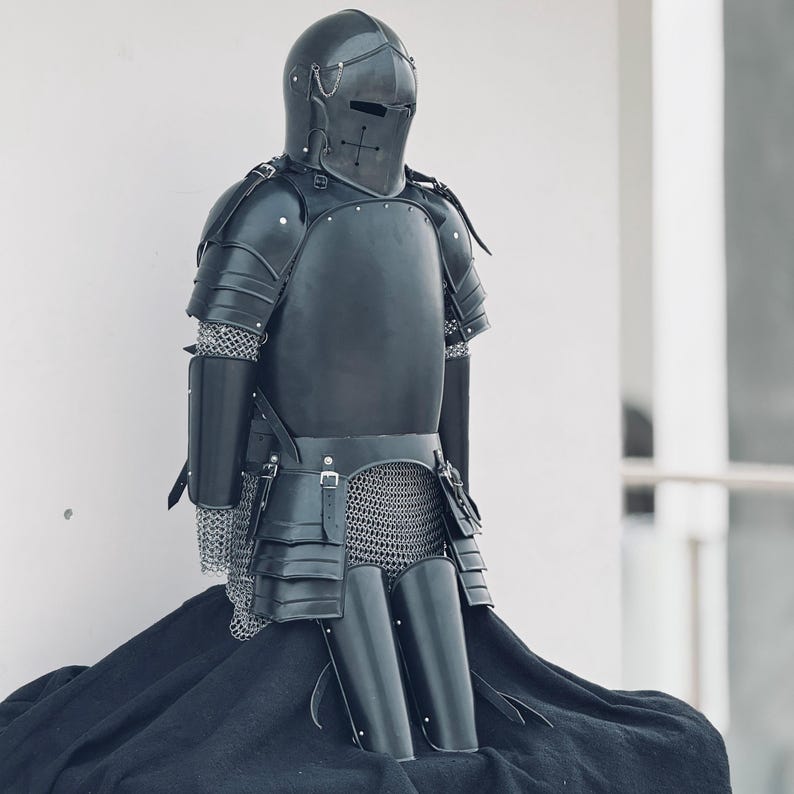
🛡️ Cotta di maglia o armatura a piastre: quale offre la migliore protezione per le rievocazioni e i collezionisti?
Condividere
🛡️ Cotta di maglia o armatura a piastre: quale offre la migliore protezione per le rievocazioni e i collezionisti?
Che tu sia un rievocatore esperto di battaglie, un appassionato di storia medievale o un collezionista di armature artigianali, la domanda che ti viene sempre posta è: cotta di maglia o armatura a piastre?
Quale delle due è migliore in termini di protezione, autenticità e vestibilità? In questa guida, analizziamo le principali differenze tra questi due iconici tipi di armatura, così potrai prendere una decisione consapevole, che tu ti stia preparando per una rievocazione storica, un set cinematografico, un cosplay o semplicemente desideri esporre un capolavoro.
⚔️ Confronto rapido: cotta di maglia contro armatura a piastre
| Caratteristica | Cotta di maglia | Armatura a piastre |
|---|---|---|
| Protezione | Ottimo contro tagli/squarci | Superiore contro la forza contundente |
| Flessibilità | Molto flessibile | Meno flessibile |
| Peso | Distribuito uniformemente | Più pesante sul corpo |
| Popolarità dell'epoca | IX-XIII secolo | XIV-XVI secolo |
| Manutenzione | Collegamenti più facili da riparare | Piastre più difficili da riparare |
| Aspetto autentico | Comune per i vichinghi, altomedievali | Adatto a stili cavallereschi e tardo medievali |
🔍 Cos'è l'armatura di maglia?
La cotta di maglia (o maille) è composta da centinaia o migliaia di anelli metallici interconnessi , che formano una maglia flessibile. Fu ampiamente utilizzata dall'antichità fino al Medioevo ed era prediletta da Vichinghi, Crociati e cavalieri dell'Alto Medioevo .
✅ Pro della cotta di maglia:
-
Ottimo contro tagli e abrasioni
-
Leggero e flessibile , consente il movimento
-
Look iconico per i ruoli vichinghi e normanni
-
Più facile da manutenere e riparare
❌ Contro:
-
Meno efficace contro la forza contundente
-
Non così intimidatorio o protettivo come il piatto
🛠️ Lo sapevi? Tutte le nostre cotte di maglia presso Artisans Hub sono realizzate a mano con le tradizionali tecniche di giunzione e rivettatura. Scopri la nostra collezione di cotte di maglia →
🏰 Cos'è l'armatura a piastre?
L'armatura a piastre apparve nel XIV secolo, offrendo una protezione superiore contro armi più avanzate come mazze, balestre e spade . Questo stile è comunemente associato ai cavalieri in armatura completa , alle giostre e ai campi di battaglia del tardo medioevo.
✅ Pro dell'armatura a piastre:
-
Offre una protezione superiore , anche contro la forza contundente
-
Impressionante copertura a figura intera per esposizione o rievocazione
-
Sembra fantastico per i ruoli tardo medievali e rinascimentali
❌ Contro:
-
Più pesante e meno flessibile
-
Richiede assistenza per indossarlo
-
Più costoso e più difficile da mantenere
🎥 Le nostre tute complete sono state utilizzate in numerosi film indipendenti e tornei di gioco di ruolo dal vivo. Scoprile →
🧑🏫 Quale dovresti scegliere?
Dipende dai tuoi obiettivi:
| Caso d'uso | La scelta migliore |
|---|---|
| Rievocazione storica vichinga o altomedievale | Cotta di maglia |
| Gioco di ruolo o cosplay completo del cavaliere | Armatura a piastre |
| Pezzo da esposizione per la collezione | O, in base all'estetica |
| Combattimento attivo (SCA, LARP) | Cotta di maglia per il movimento, piastra per la protezione |
💬 Vuoi aiuto per scegliere l'armatura giusta per le tue esigenze? Contatta i nostri esperti di Artisans Hub !
📸 L'arte dietro l'armatura
Presso Artisans Hub , ogni pezzo è forgiato a mano da abili fabbri utilizzando tecniche tradizionali tramandate di generazione in generazione. Dalla rivettatura della cotta di maglia all'articolazione dei controguanti, le nostre armature sono pensate sia per la bellezza che per la battaglia.
Ecco uno sguardo dietro le quinte a uno dei nostri armaioli mentre completa un guanto a piastre completo:
🧠 Lo sapevi?
-
Un usbergo di maglia di ferro completo poteva contenere oltre 30.000 anelli
-
L'armatura a piastre era spesso adattata su misura al corpo di un cavaliere
-
In media, la tuta completa pesava 45-55 libbre , ma era sorprendentemente indossabile!
🗣️ Ora tocca a te!
Preferisci la mobilità della cotta di maglia o la superiorità dell'armatura a piastre? Scrivi la tua opinione nei commenti!
📥 Scarica gratuitamente la nostra guida :
"Come scegliere l'armatura giusta per la rievocazione o l'esposizione"
Iscriviti alla nostra newsletter e la invieremo direttamente nella tua casella di posta.
📣 Aiutaci a diffondere la notizia
Se hai trovato utile questo post, condividilo con:
-
Un collega rievocatore o LARPer
-
La tua sezione SCA locale
-
Un esperto di oggetti di scena o uno storico cinematografico
-
Un amico che ama tutto ciò che è medievale
💡 Conosci un sito web, un blog o uno YouTuber a cui potrebbe interessare questo articolo? Inviaglielo, oppure faccelo sapere e ti contatteremo!
🎯 Suggerimento finale
Vuoi dei backlink? Aggiungi in fondo a ogni post del blog:
Se sei uno scrittore, uno storico o un creatore di contenuti, sei libero di citare o fare riferimento a questo post. È sufficiente citare Artisans Hub. con un collegamento a questo articolo.

